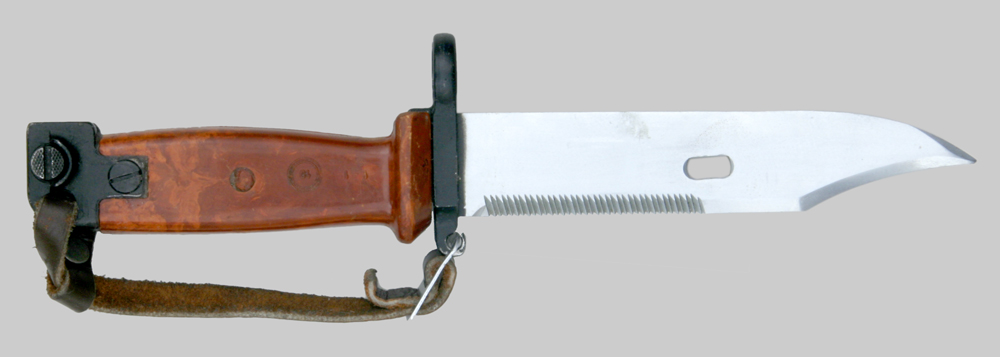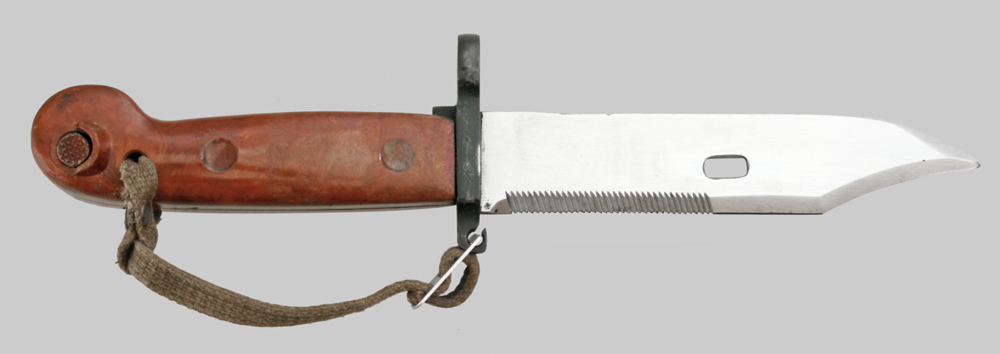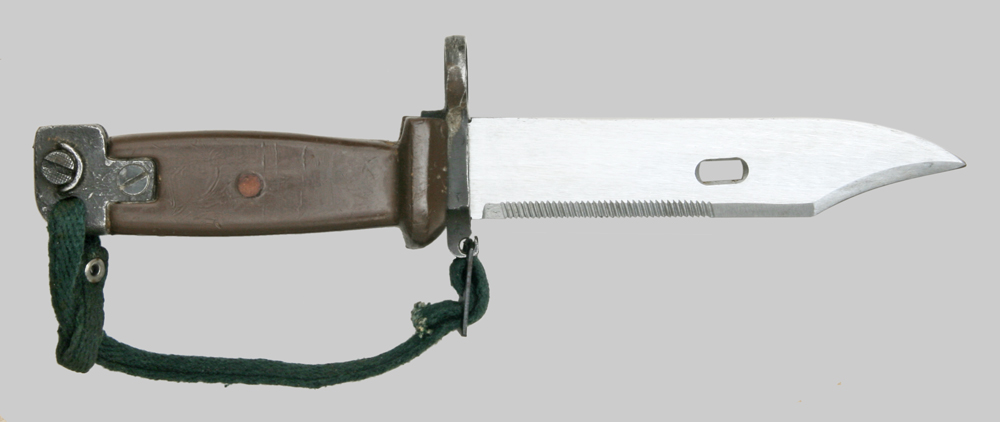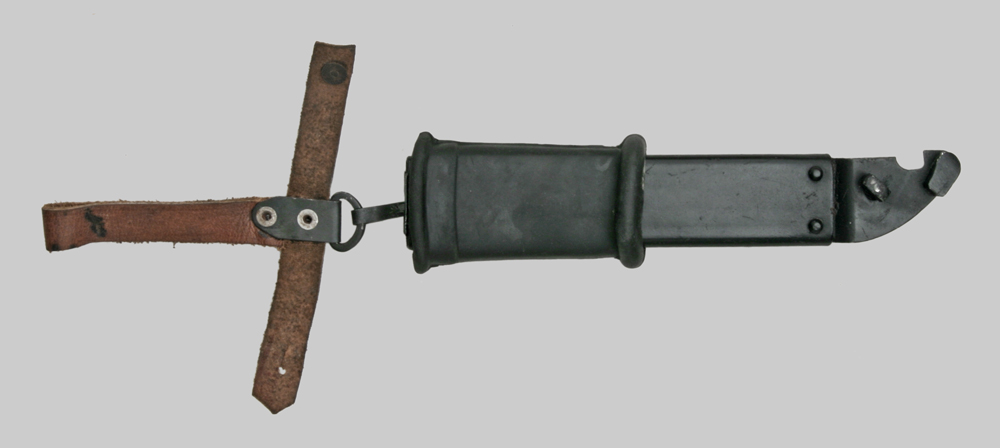As FN's superb FAL assault rifle became "the free world's right arm," the Kalashnikov AK47 and AKM became "the third world's favorite arm." Its use expanded far beyond the Soviet Union, from where it originated. Many countries manufactured the Kalashnikov and produced bayonets. A bewildering number of variations exist. Some are unique, but most differ in only minor details. This page provides a type-specific approach for identifying AK47, AKM, and AK74 bayonets, as an alternative to the country-specific index. This page is by no means exhaustive, but covers 53 different AK bayonets from 15 countries, including some unique and less common examples.
A 2018 article entitled, Bayonet evolution. Bayonet 6X2, 6X3, 6X4 and 6X5 for Kalashnikov assault rifles, by Konstantin Podgornov, has clarified many of the details concerning Russia's development and production of AK bayonets. Most AK bayonets conform to four basic types:
The AK47 Bayonet
The AK47 assault rifle was introduced during a period in history when the bayonet's future was in debate. In the decade following the outbreak of the Second World War, most of the major powers produced an infantry rifle without the ability to mount a bayonet. Without a single exception, every one was redesigned to accept a bayonet or or replaced with a rifle that did within a few years of its introduction. The AK47 was Russia's entry in this debate, being designed without the intent that it mount a bayonet. Having a change of mind, in 1955, the Russians opted for a bayonet. The AK47 bayonet hilt borrows heavily from the Swedish M1914 bayonet, another example where the bayonet was added as an afterthought. Both the AK47 bayonet and scabbard were patterned after Russia's first knife bayonet, the M1940 bayonet used with the 7.62 mm. Tokarev SVT–40 self–loading rifle. Although adequate, the dual muzzle-ring arrangement made the AK47 bayonet awkward, at best, for any other use.


The AK47 bayonet was produced by: Bulgaria, China, East Germany, Indonesia, North Korea, Poland, and Russia (shown above).
AKM Type I Bayonet
The AKM rifle was introduced in 1960. Among other things, the updated AK47 variant included a bayonet lug. Much easier and cheaper to manufacture than the AK47, production and use of the AKM went worldwide. The inclusion of a bayonet lug allowed for a more conventional bayonet. However, the new bayonet design, what we refer to as the AKM Type I, was far from conventional. It was as groundbreaking as the Kalashnikov itself. It incorporated a number of features, making for an incredibly versatile bayonet. The one-piece molded plastic grip & pommel; and stainless steel blade made the bayonet impervious to rust and rot. The unfullered clip-point blade had sawteeth along the spine. The steel scabbard body had a lug at the point that engaged a window cut into the blade, so that bayonet and scabbard could be combined as a wirecutter. The scabbard body had a rubber insulator, making it safe to cut electrified wire. The belt hanger was a clip-on affair that was cheap and easy to replace. A retention strap was also included, for extra grip when using as a combat knife. A truly revolutionary design that continues to influence bayonet design to the present day.


The AKM Type I bayonet was produced by East Germany, Hungary, Poland, Romania, and Russia (shown above).
AKM Type II Bayonet
The improved AKM Type II bayonet was introduced in 1965 and brought with it two significant changes. A squared-off steel pommel was added, to address the fragile nature of the Type I's bulbous plastic pommel. Revolutionary as it was, the Type I design couldn't change soldiers, who seem naturally inclined to use the pommel as a hammer. The second major change was a new scabbard. Advances in plastics technology had reached the point where the scabbard body could be made of molded plastic, with only a metal end for the wirecutter. This eliminated the need for a rubber insulator, as the plastic scabbard body was non-conductive.


The AKM Type II bayonet was produced by Bulgaria (shown above), China, Iraq, East Germany, Romania, Russia, and Yugoslavia. Variations were also produced by India and Vietnam (the latter are thought to have been made for commercial sale, not military use).
AKM Transitional Bayonet
A number of countries produced AKM bayonets that exhibit a mix of Type I and Type II features. The basic combinations are Type I bayonets utilizing the plastic-body Type II scabbard and Type II bayonets utilizing the steel body Type I scabbard.


The Type I bayonet/Type II scabbard combination was used by East Germany and Russia (shown above) .


The AKM Type II bayonet/Type I scabbard combination was used by Egypt (shown above), Poland , and Romania.
AK74 Bayonet
Introduced in 1986, the AK74 bayonet represents a further refinement of the AKM bayonet. Continued improvements in plastics technology enabled a return to the one-piece molded plastic grip. The AK74 grip has a stippled non-slip surface, with concentric ridges that serve as finger grooves; and, incorporates a plastic version of the Type II pommel. Improved ergonomics made the retention strap unnecessary. The AK74 introduced a radical blade cross-section, that has a flat milled on one side near the edge and a corresponding flat milled on the opposite side near the false edge. The blade has a spear point and the usual hole for use as a wire-cutter. An inspection mark is stamped on the ricasso. The scabbard is similar to the Type II scabbard.


The AK74 bayonet has only been produced by Bulgaria and Russia (shown above), where it remains in service today. Bulgaria produced an AK74 bayonet for Iraq that uses nylon webbing for the belt hanger.



